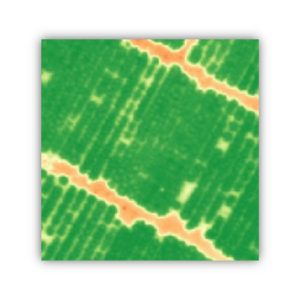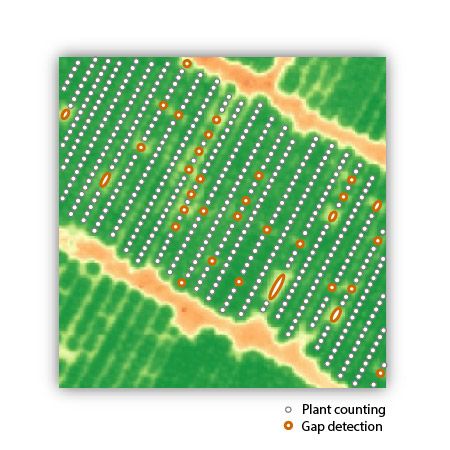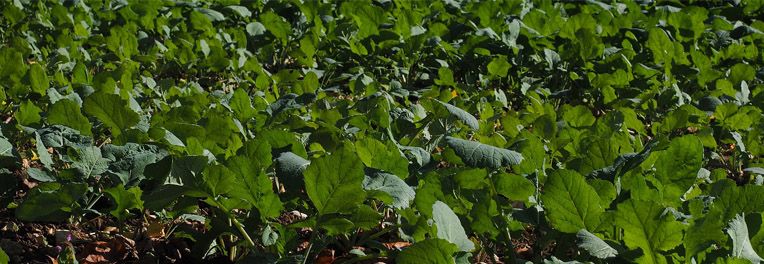SIMA – the Paris international agribusiness show – is in full swing this week! The crowd is rushing to discover the last innovations in farming, from the weather connected stations to the autonomous cabless tractor from CASE IH. SIMA whisperers confirmed that Internet of Things is one of the new buzzword – replacing drones. And that’s good news. First it means that innovation dynamics are still good. Then beyond the hype, what raises from the noise are the sound and useful solutions. Those that fix a problem and that bring real value.
Replanting decision support tool based on aerial images is one of those.
Why?
Crops damaged by hail or wind, winterkill, poor population establishment due to insects or lack of water…. The reasons to determine the plant count are various. Anyway, missing plants mean potential loss of yield. For example, a 20% gap rate in sugar cane leads to a 6% loss of productivity.
Step one in a replant decision is to assess how much the current crop has been reduced from the targeted stand. It drives the decision that has the most return: replant, abandon or care the remained plants.
The conventional method for stand count or tree count is to walk in the field, to sample a few areas by counting manually and then to extrapolate to the entire field. This is time consuming, uncomplete and not really rewarding work, with the risk of being inaccurate.
Drone acquisitions is relieving pain points in plant counting:
Time: in just one flight, drones optimized for endurance can cover more than 220 ha at 150m and acquire images where you can distinguish corn or sugarcane plants. For large plantations, you can even fly higher (if regulations permit it) and fly thousand of ha in one flight.
Labor shortage: in some areas in the world, farmers are facing huge difficulty to find workers. In one hour, a drone achieves what take days to workers.
Completeness: the drone flies over the entire field allowing to get a complete overview of the field, instead of a sample if walking in the field
Accuracy: the way you count plants might vary in the day or between two different counters. Extrapolation brings a new source of error. Drones acquisition and algorithms that count plants standardize the process and remove human errors and extrapolation uncertainty.
Safety: UAV are unsensitive to snake bites 😉
How does it work?
1. Fly. It starts with a good aerial shot (if you want to read more on this, have look to “get the crop status right”), that will allow to capture info at the plant level. Sounds a bit oversold? Just have a look at these pictures.


They were shot exactly in the same conditions (but, the plane and the camera configurations were different). The GSD are the same, but the finest details you can see are not at the same level. In the left one, you can’t see the plants. In the right one, you can see the plants, allowing to count them (and pointing out the gaps as well).
2. Count or detect gaps. For this, you need a smart algorithm, that works in most of the situations (not only on the nice use case where it was built for). This kind of algorithm has been validated on sugar cane, corn and sunflower, and as well on citrus and palm trees.
Here is an example of result for sunflower:

3.Turn it into actionable data. Synthesis at the rows and at the field level, stand uniformity, exact geolocation of gaps to know where to go replanting if you decide to replant, health of the plants: this information will drive the decision and can feed an economic analysis (taking into account additional inputs, cost of replanting, risk of replanting late for some row crops…).
4.Decide to replant or not and if yes, where… you know exactly where the gaps are located and thus where to go!
So, in a nutshell, plant counting and gaps detection with the help of a drone and smart processing algorithms is typically the kind of application that is transforming the way things are done. And, in the end, it’s not a drone story anymore… because here drone is just a tool… it’s a replanting story, with an end to end solution that supports the decision.
Some other hints on the valorization of UAVs in the ag industry coming soon, stay tuned!
To be up to date, subscribe to our newsletter!
Lénaïc Grignard, agriculture product manager at Delair-Tech
